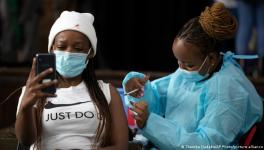COVID-19: Scientists Identify Biomarkers for Predicting Vaccine Protection
How to judge whether someone will be protected by a vaccine they have received?
One of the most puzzling questions in the current situation, this has been researched by scientists taking into account various aspects of vaccines and the immunity it generates.
One way to make such an assessment is to find a biomarker that can tell immediately whether the vaccine is able to protect a person. For instance, suppose a doctor takes the blood sample of a vaccinated person and measures the presence of some proteins or some other bio component and based on that, it could be predicated whether the vaccine will protect the person who received it. Scientists have been in the hunt for such biomarkers to judge vaccines for long.
Now, researchers developing the Oxford-AstraZeneca vaccine have claimed to have identified such biomarkers. The team has reportedly identified such a ‘correlate of protection’ from studying the immune responses of the participants in clinical trials of vaccine. The identification of blood biomarkers, according to scientists, can reduce the cost intensive large scale trials to judge efficacy of vaccines, especially for development of new ones.
David Goldblatt, a vaccinologist at University College, London, was quoted as saying, “We would like to have an antibody measure that is a reliable guide to protection because it could speed up the licensure of new vaccines.”
“The power of a correlate in vaccines is profound. If there’s a reliable correlate, then it can be used in clinical trials to make decisions as to what vaccines are likely to work, what form of vaccines are likely to work, or how durable the vaccines are going to be,” commented Dan Barouch, director of the Centre for Virology and Vaccine Research at Beth Israel Deaconess Medical Center in Boston, Massachusetts.
As for example, in case of influenza vaccines, new formulations are judged by the ability of triggering a strong enough antibody response against a protein present in the virus (influenza virus in this case) in a set of small number of people, which reduces the time and cost of conducting large trials.
The Oxford-AstraZeneca team’s biomarker results have been published in the preprint server medRXiv recently.
The typical way of determining the ‘correlates of protection’ is by comparing immune responses of trial participants that were protected by a vaccine with those volunteers who got infected despite having a vaccine shot. Those volunteers who were vaccinated but still became infected are the ‘breakthrough cases’.
In the case of COVID-19 vaccines, it has been difficult to find out markers of protection based on the breakthrough cases, because there are many vaccines with high level of efficacies.
Prior to the Oxford-AstraZeneca study, there have been attempts by other researchers as well to determine the markers of protection.
The Oxford-AstraZeneca study confirms the relation between higher levels of neutralising antibodies and protection. The study compared the immune response in 171 breakthrough cases among over 1,400 participants who were vaccinated and did not develop symptomatic infection.
The researchers found that participants having higher levels of neutralising antibodies along with binding antibodies were more likely to be protected from symptomatic infection. The team also used a model to estimate the antibody levels corresponding to levels of protection against COVID-19 provided by the vaccine. Their model accommodated a range of protection from 50% to 90%. If any other vaccine has to be judged for its protection-providing capability, then the vaccine can be compared to the model used in the Oxford study.
However, scientists have pointed out several caveats. Miles Davenport, immunologist from Australia who is associated with the University of New South Wales, Sydney, Australia, commented, “There was no significant difference in the neutralising antibody responses of breakthrough infections and controls. This could occur if young people at greater risk of infection — because they have more social contacts, for example — also had higher antibody levels.”
The Oxford team accounted for this by estimating risk of infection of the participants. Davenport, again apprehensive, said, “It's a challenge to identify protective antibody levels based on estimated risk, rather than observed differences in antibody levels — which would have been possible only if there were clear differences between breakthroughs and controls.”
David Goldblatt also had critical comments, “It’s not certain whether the antibody levels established in the study will be able to predict the success of other vaccines, particularly those based on different technologies. We don’t want to develop something just for one vaccine or one kind of vaccine. We’ve got all these manufacturers around the world, developing vaccines based on different platform.”
Notably, the earlier studies in this regard also focused on neutralising antibody levels and the corresponding level of protection provided by a vaccine. Reportedly, such a ‘correlates of protection’ study is also undergoing in US for Moderna and Johnson & Johnson’s vaccines. The Moderna results are expected to come out soon.
Get the latest reports & analysis with people's perspective on Protests, movements & deep analytical videos, discussions of the current affairs in your Telegram app. Subscribe to NewsClick's Telegram channel & get Real-Time updates on stories, as they get published on our website.























